As someone fascinated by historical fashion, particularly the elegance of Victorian gowns, and deeply rooted in the spirit of the Southwest, I’ve often pondered the clothing of pioneer women. Being an Arizona native and a Daughter of Utah Pioneers now living in Denver, this intersection of interests has led me to explore how pioneer clothing on the Western frontier differed from contemporary Eastern city styles.
Pioneer women’s wardrobes were a careful balance of practicality, social expectations, and personal expression. This article delves into the essential elements of their attire, from undergarments to outerwear, providing insights into the daily and special occasion dressing of women in the American West during the 19th century. Join me as we uncover the fascinating story of Pioneer Woman Dressing.
Defining the Frontier Context
For this exploration of pioneer woman dressing, we’ll focus on the regions west of Missouri and Arkansas, spanning roughly from 1850 to 1890. The fashions discussed primarily pertain to women homesteaders and those within settlement communities. While the frontier experience was diverse, this article will largely reference the clothing of white settlers migrating westward from the East.
It’s important to appreciate that pioneer clothing was less about displaying social status and more about reflecting the shared experience of families pursuing their dreams in the uncharted West. Practicality and adaptability were key, yet pioneer women also strived to maintain a sense of decorum and personal style within their challenging new environments.
The Foundation: Underclothes
Interestingly, the undergarments worn by pioneer women were not drastically different from those fashionable in Eastern cities. The chemise, a simple, lightweight cotton slip, was a fundamental piece, prioritized for hygiene and frequent washing. Pantalets, made of flannel or cotton, were worn for modesty, serving a similar purpose to modern underwear.
Contrary to assumptions of stark frontier living leading to relaxed standards, corsets were a common undergarment among pioneer women. Many women venturing West were driven by aspirations for a better future, whether for economic or religious reasons. They considered themselves “proper” women and viewed the corset as an essential garment, maintaining a sense of respectability in their new surroundings.
While corsets might be loosened or forgone during strenuous housework, pioneer women generally brought corsets with them and wore them whenever feasible.
Following the corset came petticoats, often multiple layers depending on the formality of the occasion or the weather. Stockings were essential when leaving the house or receiving guests, typically held up by garters or tucked into pantalets – a method that might sound rather uncomfortable by today’s standards.
Fabrics of the Frontier
Calico was the quintessential fabric for pioneer clothing. Often imagined as dainty floral prints, calico is actually a plain-woven cotton fabric, slightly lighter than canvas and made from unprocessed cotton. Its lightness, durability, and ease of cleaning made it ideal for the demands of outdoor life. Calico was available in various dyed options at general stores, or women could dye it themselves using commercial dyes or natural pigments derived from plants like leaves, bark, berries, and fruits.
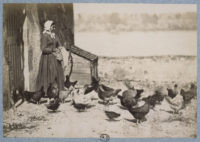 Pioneer woman in calico dress and apron tending to her garden, showcasing practical pioneer woman dressing.
Pioneer woman in calico dress and apron tending to her garden, showcasing practical pioneer woman dressing.
Cotton and silk fabrics were still valued for “Sunday best” attire and more formal dresses. Pioneer women often brought such garments from their former homes in the East.
Fabrics could be purchased at general stores, though accessibility varied depending on location. In more remote areas, families might have had to produce their own fabrics, a complex skill deserving of its own discussion.
Daily Wear: Adapting to Frontier Life
Regardless of their backgrounds, pioneer women in frontier settlements were actively involved in establishing and maintaining homes and farms. Their days were filled with cooking, cleaning, childcare, laundry, and often field work. The success of family farms depended on everyone’s physical labor, with no option to outsource domestic tasks. Pioneer women quickly adapted to a life of manual work, and their clothing reflected these practical needs.
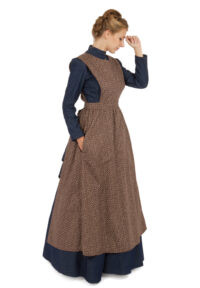 Close-up of a pioneer calico apron, highlighting a key element of pioneer woman dressing for daily chores.
Close-up of a pioneer calico apron, highlighting a key element of pioneer woman dressing for daily chores.
General dress styles of the era, featuring fitted bodices and full skirts, remained popular in pioneer woman dressing. However, practical modifications were essential. Daily wear skirts were typically hemmed about three inches shorter than fashionable lengths, facilitating movement for chores. Weights were sometimes sewn into hems to prevent skirts from blowing up in windy conditions, maintaining modesty and practicality.
Bodices remained fitted, but sleeves were loosened and extended to the wrists, often paired with high collars to protect the skin from the sun.
Laundry was a significant undertaking. Interestingly, “wash dresses” gained popularity for their ease of care. As mentioned in How the West Was Worn by Chris Enss, a simple two-piece dress of white cotton with a printed pattern became fashionable around 1867. Its easy-to-launder nature made it desirable across socioeconomic levels, whether store-bought or made at home. This “wash dress” exemplifies how pioneer woman dressing adapted to the realities of frontier life.
Sunday Best: Maintaining Social Graces
While frontier life could be isolated, settlements often established churches, and attending services was a vital community activity. Although accounts exist of women in impoverished communities attending church barefoot, it was more common for pioneer women to have dedicated “Sunday best” dresses. Historical records often focus on more affluent settlers, making it challenging to definitively know the most typical experience.
 A pioneer couple dressed in their Sunday best, illustrating formal pioneer woman dressing for church and social events.
A pioneer couple dressed in their Sunday best, illustrating formal pioneer woman dressing for church and social events.
Pioneer women’s “Sunday best” resembled fashionable city attire. Full skirts over petticoats and corsets were standard. Sleeve styles of the time, such as bell, leg-o-mutton, or pagoda sleeves, were incorporated. Skirt styles also followed current trends, whether crinoline, hoop, or bustle, depending on the decade.
Younger and newly married women often chose lighter colors for their Sunday dresses, transitioning to darker shades as they aged. Fashionable hats, kid gloves, and low-heeled boots completed the ensemble, showcasing a desire to maintain social graces through pioneer woman dressing.
Dressing for Socializing on the Frontier
Beyond daily and Sunday wear, pioneer women, when possible, reserved dresses specifically for social occasions. Dances, holiday celebrations, picnics, and community gatherings were important for social connection. Just as in Eastern cities, pioneer women understood the importance of dressing appropriately for these events.
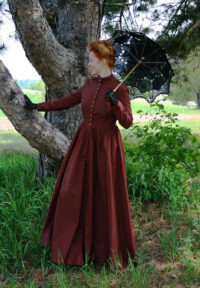 Woman in an elegant Victorian cotton dress, representing pioneer woman dressing for church and special occasions.
Woman in an elegant Victorian cotton dress, representing pioneer woman dressing for church and special occasions.
These social dresses were highly valued. Women might order fabrics from general stores and eagerly await the opportunity to create fashionable outfits, often inspired by publications like Godey’s Ladies Book. This magazine was widely circulated and shared among frontier women, who enthusiastically copied dress patterns and styles featured within its pages.
Fabric availability for these dresses depended on the proximity and accessibility of general stores. In many cases, a limited wardrobe meant that the “best” dress served for special events, with accessories used to elevate the look. Hand-crocheted collars, shawls, and other accessories became crucial for adding versatility and style to pioneer woman dressing.
Accessorizing on the Frontier
Accessories played a surprisingly significant role in pioneer woman dressing. Beyond the foundational garments and dresses, finishing touches were highly valued. Jewelry and accessories were emphasized in historical accounts, highlighting their importance in completing and personalizing an outfit.
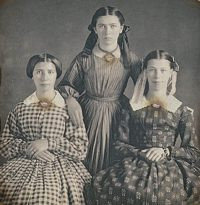 Two young pioneer girls wearing bonnets and aprons, showcasing the importance of accessories in pioneer woman dressing.
Two young pioneer girls wearing bonnets and aprons, showcasing the importance of accessories in pioneer woman dressing.
Women on the frontier enjoyed accessorizing with:
- Aprons
- Boots
- Brooches
- Lockets
- Earrings
- Precious stones and metals
- Hair adornments
- Hats
- Collars and cuffs
- Gloves
- Undersleeves
- Parasols
- Fans
- Handbags
- Shawls
These accessories allowed pioneer women to express individuality and adapt their limited wardrobes for various occasions, demonstrating that pioneer woman dressing was not simply about practicality but also about personal style and social expression.
A Surviving Legacy
Exploring pioneer woman dressing offers a fascinating glimpse into the lives of women in the American West. As I delve deeper into my own pioneer ancestry, I recognize the resourcefulness and resilience of these women. Despite the challenges of frontier life, they navigated their desire for propriety, beauty, and fashion while facing demanding physical labor and new environments.
While “prairie style,” “pioneer,” and “western wear” clothing are readily available today, understanding the historical context of pioneer woman dressing reveals a more nuanced and compelling story of adaptation, community, and personal expression.
Create Your Own Pioneer Look:
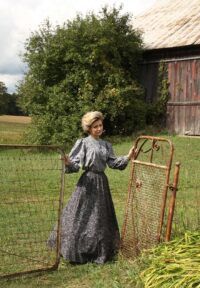 A woman dressed in pioneer clothing, featuring a blue blouse and skirt, demonstrating a modern interpretation of pioneer woman dressing.
A woman dressed in pioneer clothing, featuring a blue blouse and skirt, demonstrating a modern interpretation of pioneer woman dressing.
Browse our entire pioneer clothing collection
Pioneer Calico Blouse and Skirt
Harper Victorian Pioneer Dress
Pioneer Blouse, Apron and Skirt
